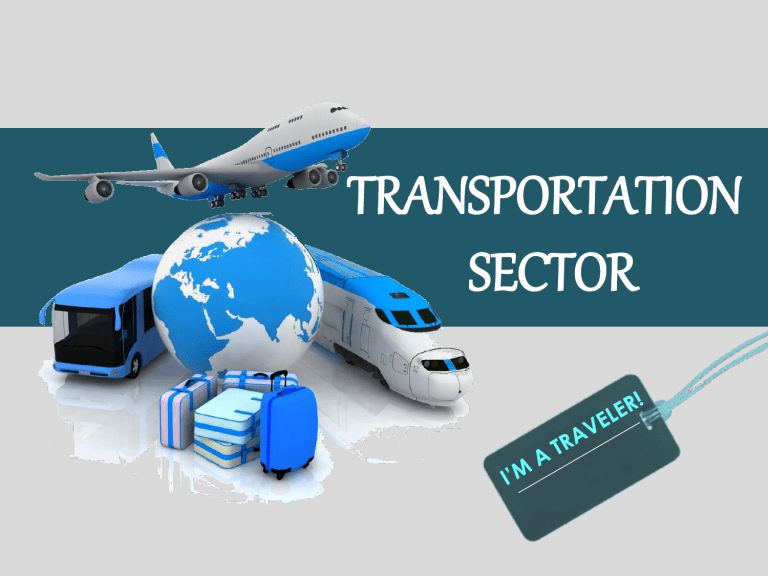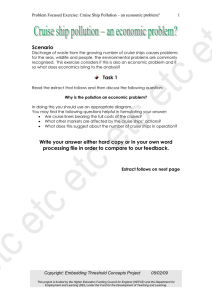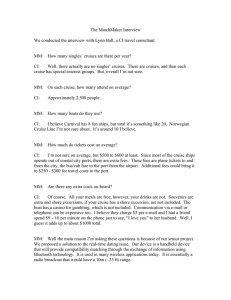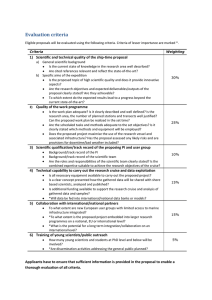
TRANSPORTATION SECTOR Transportation and Travel Evolution Pre-Industrial Travel System Era • This was the period before the widespread industrialization in Europe and North America. • There were almost no regularlyscheduled transportation services. • There was little travel. • Only few people had the money and the reason to travel. Transportation and Travel Evolution Early-Industrial Travel System Era • Road improvements such as railways, canals, and steamship services were brought about due to rapid industrialization and advances in transportation technology. • Common carriers came into existence and began to offer regularly-scheduled transportation services. • Travel increased because more people who had money to travel. Transportation and Travel Evolution Mature-Railway System Era • This era was characterized by railway by which expanded their operations by running hotels and providing other travel-related services. • Travel agencies and tour companies were formed. • Thomas Cook, an innovator in this field during this era, began his company’s activities in the UK in 1840. • More people traveled. Transportation and Travel Evolution Express-Travel System Era • Express services increased. • Trains and other forms of transportation did not stop at every station or terminal but only at the major ones. • This increased the speed of travel and encouraged more travel than before. Transportation and Travel Evolution Automobile-Based Travel System Era • Car ownership boomed in North America. • Motorways, interstate highways, and other trunk highways were developed in the later half of this era which was from 1920-1974. • The automobile was predominant over other travel modes from 1920-1945. Transportation and Travel Evolution Modern-Tourism Travel System Era • The period from 1945-1974 is known as the modern tourism system era. • Car ownership continued to grow at a fast rate, mainly at the expense of long-distance rail travel. • The introduction of wide-bodied jets in 1970 greatly increased air travel. • The “mass tourism” philosophy and marketing approaches were prevalent during the 1950’s and 1960’s. Transportation and Travel Evolution Post-Mobility Adjustment Era • This era began in 1973-1974 as a result of the oil embargo generated by OPEC and the resulting increase in fuel prices. • The events of the energy crisis basically changed the travel patterns throughout the world. • The present era is one in which travelers continue to look to alternative, grouporiented modes of transportation. Historical Development of Transport Systems the airline industry December 17, 1903 – at Kitty Hawk, North Carolina, Orville and Wilbur Wright launched the aviation age when Orville made the first controlled, sustained flight in a motorized, heavierthan-air craft. definition • • • • • Airline Industry is a system of transportation Part of Aviation Industry Moving people and goods Utilizing the airways One of the only true global business type of airlines • Scheduled (fixed routes and timings) • Non-scheduled • Passenger • Cargo • Passenger and Cargo • Intercontinental • International • Domestic Freedoms of the Air • Freedoms of the air or traffic rights are aviation agreements between two countries which grant a country’s airline(s) approval to enter and land in another country’s airspace. • Formulated as a result of disagreements over the extent of aviation liberalization in the Convention on International Civil Aviation of 1944, known as the Chicago Convention. Freedoms of the Air FIRST FREEDOM: The right of an airline to overfly one country to get to another Freedoms of the Air SECOND FREEDOM: The right of an airline to land in another country for a technical stopover (fuel, maintenance, etc.) but does not pick up or drop off traffic. Freedoms of the Air THIRD FREEDOM: The right of an airline, registered in country X, to drop off traffic from country X to country Y Freedoms of the Air FOURTH FREEDOM: The right of an airline, registered in country X, to carry traffic back to country X from country Y. Freedoms of the Air FIFTH FREEDOM: The right of an airline, registered in country X, to collect traffic in country Y and fly on to country Z, so long as the flight either originates or terminates in country X. Freedoms of the Air SIXTH FREEDOM: The right of an airline, registered in country X, to collect traffic to a gateway—a point in country X—and then abroad. The traffic has neither origin nor ultimate destination in country X. Freedoms of the Air SEVENTH FREEDOM: The right of an airline, registered in country X, to operate entirely outside of country X in carrying traffic between two other countries. Freedoms of the Air EIGHTH FREEDOM: The right of an airline, registered in country X, to carry traffic between any two points in the same foreign country; also known as cabotage. Freedoms of the Air NINTH FREEDOM: The right of an airline, registered in country X to carry cabotage traffic of country Y on a service performed entirely within the territory of country Y. That is a foreign carrier operates domestic services. Airline Deregulation • is the process of removing government-imposed entry and price restrictions on airlines affecting, in particular, the carriers permitted to serve specific routes. • In 1978, the U.S. congress passed the Airline Deregulation Act of 1978 which provided for the gradual phasing-out of the Civil Aeronautics Board (CAB) and removed many of the regulations governing air carrier routes and fares. • A new form of regulation has been developed to some extent to deal with problems such as the allocation of the limited number of slots available at airports. Airlines of the Philippines • AIRASIA ZEST – Z2 • CEBU PACIFIC – 5J • PAL EXPRESS – 2P • PHILIPPINE AIRLINES – PR • PHILIPPINES AIRASIA – PQ • TIGERAIR PHILIPPINES – DG • SKY PASADA – SP • SKY JET – 5M • ITI AIR – D5 International Carriers • CATHAY PACIFIC • CHINA AIRLINES • DELTA AIR • DRAGON AIR • EMIRATES AIRLINES • ETIHAD • JEJU AIR International Carriers • QATAR AIRWAYS • ROYAL BRUNEI • SINGAPORE AIRLINES • THAI AIRWAYS • UNITED AIRLINES New Planes • Airbus A380 is the largest commercial airliner ever designed. It has twin decks and seats 555 passengers in the typical three-class configuration of service. New Planes • Boeing 787 Dreamliner is a long-range, midsize wide-body, twinengine jet airliner. Its variants seat 210 to 335 passengers. It is Boeing's most fuel-efficient airliner and the world's first major airliner to use composite materials as the primary material in the construction of its airframe. the railway industry RAILWAYS • Considered one of the earliest modes of transportation. • Serves as one of the major transport services in many countries. – Includes: India, Japan, China and South Korea. – Widespread in European countries RAILWAYS • To date, this mode of transportation still attracts travelers as they continue to offer : – Comfort – Reasonable fares and; – Less travel time The Eurail • The Eurail also known as the Eurorail • One of the most extensive railway systems in the world. • Its major product, offers rail passes for train travel all across Europe The Eurail Passes Types • Global Pass: – The Eurail Global Pass lets you visit 23 countries throughout Europe, and see them in any order you like. • Select Pass: – Gives you flexibility to plan your trip, and also comes with the most options. – Can choose from 3, 4 or 5 bordering countries and 5 up to 15 travel days. The Eurail Passes • Regional Pass: – Combine two bordering countries. – Offer the ability to concentrate your European adventure within a specific region. • One Country Pass: – The Eurail One Country Pass is for if you want to spend your time exploring one country or area. – Valid for one month, and the number of travel days available varies per country. The Eurail Passes • Unfortunately this service is not available for everyone. – Not available for residents of Europe, the UK, Morocco, Turkey, or any of the countries of the former Soviet Union. – If you are a citizen of any of these countries, but are a resident of the United States, Caribbean, Mexico, Central America or Canada, Eurorail are able to sell the rail pass or tickets to you. – Passes are based on residency not citizenship, and the country of your residence will be printed on the rail pass as well as the names on the pass and on the passport have to match. Undersea Railway Tunnels • Links two countries or areas that are separated by bodies of water through an undersea tunnel. Undersea Railway Tunnels • The Channel Tunnel – Aka Chunnel; Euro tunnel – Connects France and Britain – Stretches around 49.89 kms – The Longest Tunnel underneath the sea. – Consists of three tunnels. The first 2 tubes serve rail traffic. The third is an emergency escape route. Undersea Railway Tunnels • The Seikan Tunnel – Located in Japan – The longest seabed tunnel in the world. – Passes by the Tsugaru strait to the Honshu and Hokkaido islands Amtrak • Amtrak is the marketing name for the National Railroad Passenger Corporation • Provides rail passenger transportation in the major intercity markets of United States. Amtrak • Amtrak launched its Acela Express service between Boston and Washington, D.C., in December 2000 to serve the Northeast Corridor. • Passengers can enjoy high-speed rail travelling at 150 miles per hour in modern comfort. High-Speed Rail Shanghai Maglev Train The Shanghai Maglev Train or Shanghai Transrapid with an operational speed of 430km/hr and average speed of 251 km/hr is a magnetic levitation train launched in China in 2003. High-Speed Rail Shinkansen (Bullet Train) Many would credit Japan with being the inventor of the concept because in 1964, the country launched the famous Shinkansen with speed of 210 km/h. High-Speed Rail TGV (Train à Grande Vitesse) A French high-speed train, TGV holds the world record hitting a top speed of 574.8km/hr. However, its operational speed is 300-320 kmph. the motorcoach industry Motorcoach • is a type of bus used for conveying passengers on excursions and on longer distance intercity bus service between cities—or even between countries. Motorcoach • Unlike transit buses designed for shorter journeys, coaches often have a luggage hold that is separate from the passenger cabin and are normally equipped with facilities required for longer trips, including comfortable seats and sometimes a toilet Executive Motorcoach • Executive motor coaches offer a higher level of comfort and luxury and are great for special business and social occasions • It is a mobile office, and a boardroom on wheels. • An Executive bus may have a conference room, galley, shower, and luxurious seating. Executive Motorcoach • An executive motor coach is ideal for groups of 5 to 20 traveling 300 to 400 miles. • It is also a good option for local outings, such as corporate meetings or transporting wedding parties, when you want a more intimate setting for your group. Advantages of Motorcoach Travel 1. 2. 3. 4. 5. 6. No driving Hassle-free planning Expertise of a Tour Guide Socialize Safety It’s great for the environment the automobile The Automobile • Most of the travel in the world takes place in the automobile. • The real inventor of the automobile was Car Benz, of Mannheim, Germany. • Brought decline of the train’s popularity in most developed countries. • Auto travel is the most inexpensive and convenient form of travel. The Automobile • The growth of car ownership necessitated road improvements. • Two important aspects of automobile travel are: - Car Rentals - Recreational Vehicles Rental Cars • The car rental business is a world-wide industry. • Four countries dominate the U.S. market with 85 percent market share. • These are Hertz, Avis, Budget, and National. • Hertz is the airport market leader. Rental Cars • Air travel is critical to the car rental business as airport revenues account for much of overall car rentals in the US. • Hertz is the airport market leader with about 29 percent of the airport rental business. Rental Cars • Computerized navigation systems have come to rental cars and are predicted to be a growing attraction. Bookings over the internet is increasing. the cruise industry Sea Transportation • Watercraft carrying people or goods. Sea transport has been the largest carrier of freight throughout recorded history. • Can be over any distance by boat, ship, sailboat or barge, over oceans and lakes, through canals or along rivers. Cruise Ship • Vacation trip by ship. • Travelling by water for purely recreational purposes. This is a leisure vacation experience with the ships staff doing all the work. • Is both a floating hotel and resort. • Provides entertainment • Opportunities to socialize is one of its major attractions. Array of Cruise Line Brands Largest Cruise Liners Carnival Corporation • largest cruise liner • a British-American owned cruise line, based in Doral, Florida, a suburb of Miami in the United States. Largest Cruise Liners Royal Caribbean International • 2nd largest • founded in Norway and based in Miami, Florida in the United States • All ships under the Royal Caribbean International brand have had names ending in "of the Seas" since 1991. Largest Cruise Liners Star Cruises • 3rd largest • dominates the Asia-Pacific market and is owned by Genting Hong Kong, who also owns 28% of the Norwegian Cruise Line. Ship Size Ships are sized in the following ways: • Based on the number of staterooms; • Based on the number of passengers it can accommodate; and • Based on the Gross Registered Tonnage (GRT) Ship Size NUMBER OF PAX GRT Very Small Under 200 pax Under 10,000 GRT Small 200-500 pax 10,000-20,000 GRT Medium 500-1,200 pax 20,000-50,000 GRT Large 1,200-2,000 pax 50,000-70,000 GRT Megaship More than 2,000 pax 70,000 GRT or more Largest Cruise Ships Allure of the Seas (Royal Caribbean International) • • • • • 2010 Gross Tonnage: 225,282 GT Length: 1,187 ft Staterooms: 2,706 Passenger Capacity: 6,360 Largest Cruise Ships Oasis of the Seas (Royal Caribbean International) • • • • • 2009 Gross Tonnage: 225,282 GT Length: 1,187 ft Staterooms: 2,706 Passenger Capacity: 6,360 Largest Cruise Ships Norwegian Epic (Norwegian Cruise Line) • • • • • 2010 Gross Tonnage: 155,873 GT Length: 1,081 ft Staterooms: 2,114 Passenger Capacity: 5,183 Largest Cruise Ships Freedom of the Seas (Royal Caribbean International) • • • • • 2006 Gross Tonnage: 154,407 GT Length: 1,112 ft Staterooms: 1,817 Passenger Capacity: 4,375 Largest Cruise Ships Liberty of the Seas (Royal Caribbean International) • • • • • 2007 Gross Tonnage: 154,407 GT Length: 1,112 ft Staterooms: 1,817 Passenger Capacity: 4,375 Ships Facilities There are three types of facilities: 1. Stateroom Space 2. Private Space 3. Public Space Ships Facilities Stateroom Space • The cabin • The ship’s equivalent to the guest room of the hotel • Has three types: - Outside Staterooms rooms that have windows - Inside Staterooms inside the ship’s interior, have no windows - Suites most expensive accommodation in a ship Ships Facilities Private Space • This includes the Bridge, the galley or kitchen and the mechanical areas • Mostly employees areas only. Ships Facilities Public Areas • Where the passengers/guests mingles Public areas include the following: • The Reception Area • The Dining Room • Alternative Dining Areas • The Showroom • The Pool Area • The Health Club • Medical Facilities • Movie Theatre TRANSPORTATION SECTOR


